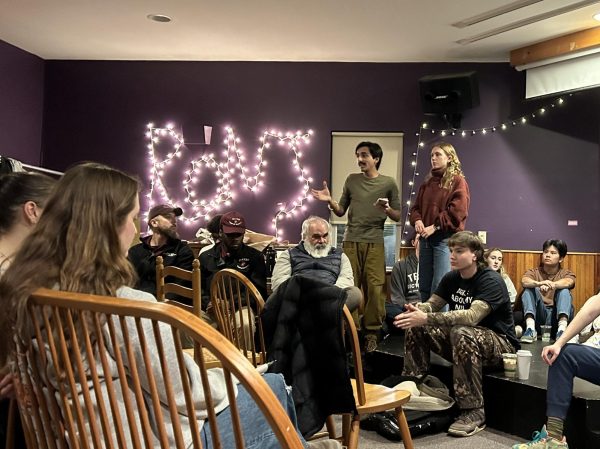A Bobcat’s Guide to Online Learning in the Time of Social Distancing
Up until a few weeks ago, an online campus at Bates was an unheard of prospect. Now, with the outbreak of COVID-19, faculty and students are left with the difficult challenge of finding a virtual alternative to face-to-face interaction.
With online learning comes the added challenge of accommodating students living in widely different circumstances, like different time-zones and situations at home. These issues have raised many equity concerns, causing some professors at Bates to have students submit assignments for the rest of this school year. In a Bates Student Instagram poll, 66% of 150 students claimed that classes have chosen to continue in this fashion. However, a smaller percentage of professors have stuck with holding regularly scheduled classes via video chat in addition to submitting assignments remotely.
Over the past few weeks, The Bates Student team has experimented with some of the major online-communications platforms in an effort to find the best mode of interaction for classes and student-run organizations. Although there are many options to choose from, we have stuck with well-known and established platforms such as Google Hangouts, Zoom, and Slack. Overall, we have found that while none of the platforms are perfect, if combined they can prove very effective for carrying out group projects.
[cmtoc_table_of_contents]
Google Hangouts
For Bates faculty and students, Google Hangouts can be a no-brainer. It is included with the G Suite and is an all-in-one platform with built-in video conferencing and online messaging. In addition to video and messaging, it has all G Suite apps like Gmail and Google Drive already integrated—making group collaboration particularly convenient. Out of the other options in this list, Google Hangouts exceeds in simplicity and convenience marks.
Pros
- Free to use, no limit to storage while on a Bates G Suite account
- Best option for informal, smaller groups under 5 people.
- This platform is already integrated with other Google products. This means that you can schedule a video conference as a Google Calendar event, and invite guests through creating an event.
- To start a call, many options are available. You can invite guests by sending an online link through desktop or mobile app, manually adding email addresses, and/or providing a dial-in number.
- Google Hangouts also offers a live caption option during video calls.
- Unlike Slack or Zoom, messaging and video chatting are built into the same platform by default. There is no need to add extensions.
- You can use Google Hangouts in a browser without downloading an app
- Has a “presentation mode” which allows teachers to share their screen with students during a video call.
- Host can both mute individuals’ microphones and remove people from the conversation.
- There is also a chat available for everyone in the meeting. After the call has ended, you can still access the Hangout group’s message history.
- You can record meeting, and when finished, it will automatically be sent to your Google Drive
Cons
- You have to manually send email invitations for a group chat
- It’s pretty easy to miss a video call. You do not get a notification on your browser when a call starts unless you have Hangouts open. Otherwise, the only way to get notified is via an invitation link sent through email or text.
- The default video and audio quality is the worst on this list, however you can alter video resolution in settings.
- There is no option for the host to end the meeting for everyone. This means that people can stay on the video even after the host leaves.
- For the free version, 25 is the max amount of people that can join a call with up to 10 visible at once. However with the paid version of Google Hangouts Meet for enterprises up to 100 people can be in a video call.
- Slightly more limited than Zoom when it comes to customizability.
Zoom
Zoom is a cloud-based video conferencing, online meeting, and group messaging platform launched in 2011. Even though it is a newer video conferencing application, it sits at or near the top of most lists of video conferencing applications. It can be accessed in desktop and mobile versions, and allows users to share video, audio, and screens across Windows, Mac, IOS devices and Androids, among others.
Pros
- Most user friendly option on this list.
- More professional and business oriented than Skype or Google Hangouts.
- Up to 100 people can be in a call in the free version, with up to 49 people available to be seen at once.
- Better for video calls over 10. It offers a free basic tier that allows you to host up to 100 participants and have unlimited one-to-one meetings. After that, there are paid tier options that allow you to increase participants.
- The leader of the team makes a zoom meeting and they can set the time for the zoom meeting whenever they want. The link can be edited in which people can either have access to microphone or video depending on what the leader does.
- The host can mute and unmute certain people and can remove people from the conversation.
- You also have options on what part of the screen to share with others. For instance, you can share just a browser window or your entire desktop screen.
- The audio and visual quality in Zoom video chats outperforms competitors like Google Hangouts.
- Compared to other video conferencing applications, there does not seem to be many glitches when it comes to Zoom technology.
- You have the option to call in instead of using wifi.
- Unlike Google Hangouts, there is a waiting room option for people to wait in before the meeting starts.
- You can add polls as well as Q&A features to your Zoom meetings.
- There’s an annotation feature that you can use to highlight or markup your screen
- You can record webinars for students who are in different time zones. In paid versions, you have the added option of uploading automatically to the cloud.
- You can change the background of a Zoom call, which can prove to be entertaining.
Cons
- The major downside of Zoom is that all meetings with over 3 people cannot be over 40 minutes under the free plan. To have meetings over 40 minutes, you must have a paid plan. In the free version, meetings will shut down with no advanced warning if you go over the time limit.
- You cannot start or join a conversation from a browser like Google Hangouts, instead you have to download a Desktop or Mobile Zoom app.
- Zoom does not offer toll-free dial-in numbers for the US or the UK.
Slack
Unlike Zoom or Google Hangouts, Slack is not a video conferencing software. However, out of the options on this list, it is the best option for courses that have forgone video classes in favor of submitting assignments. It is also a great option for clubs and student organizations, as it is much more efficient and customizable than emails and other forms messaging.
Pros
- You can be a part of multiple workspaces at once, meaning that a teacher or club member could have a different workspaces for different classes or groups.
- There are channels within workspaces that can either be public for members in the workspace or private/ invite-only.
- You can also have direct messages with workspace members.
- Many integrations are available for Slack, including G Suite apps, Microsoft Office tools, and Zoom.
- It is easier to look up message history in Slack than it is in email or text messaging.
- You can share images and other files in channels that can either be previewed or downloaded.
Cons
- If you go over 10,000 messages in the free version, you no longer have access to search older data.
- Important and longer information can get buried in channels, which means that some messages should go through
- Although there is no default/ built-in video call option, you can add Zoom as an extension for everyone in the workspace and invite people to join calls in your channels.
Summary
The COVID-19 pandemic has irrevocably changed the way we live and interact with each other on a global level. Now more than ever, workers and students have been forced to be flexible in order to get work done. For Bates students in particular, many of the things taken for granted, like walking to class or meeting friends in Commons, seem like distant luxuries. Unfortunately there is no one-fits-all solution to learning and getting work done remotely. For us at The Bates Student, we have used each of the options on the list to meet our varying needs of communication. Hopefully this guide can prove useful to meet others’ needs in the Bates Community.










